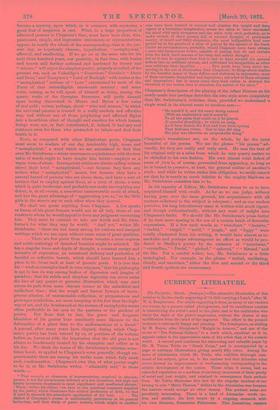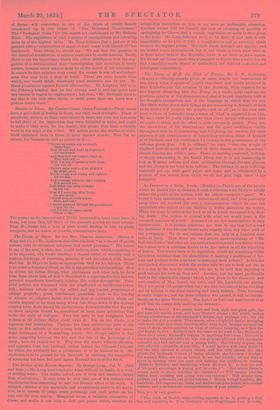CURRENT LITERATURE.
The Portfolio. March. (Seeleys.)—The attractive illustration of this number is the fac-simile engraving of "A Girl carrying a Lamb," after M. W. A. Boug-noreau. Fac -simile engraving is done, as many of our readers are aware, by a process called photogravure, and its excellence consists in transferring the artist's mind to the plate, and to the multitudes who enjoy the sight of the plate's impression, without the chance of any modification from the mind of the engraver. The effect in the present instance is extremely happy and pleasing. The frontispiece, an etching by M. Haien, after Giorgione's "Knight in Armour," and one of the series of "The National Gallery," is a work which, excellent as it is, appeals rather to the appreciative taste of the artist than of the outside world. A second part continues the interesting and valuable paper by Mr. H. Virtue Tebbe on "Greek Coins," and is accompanied by a page of autotype illustrations, giving nearly fifty coins. Among the mass of information which Mr. Tebbs, who exhibits thorough com- mand of his subject, gives us, is the curious fact that Athenian coins never showed an improvement of workmanship corresponding to the artistic development of the nation. These coins, it seems, had an extended reputation as a medium of currency, on account of their purity of metal and just weight, and retained in consequence their archaic. form. Mr. Tebbe illustrates this fact by the singular incident of our having to coin "Maria Theresa" dollars in the Abyssinian war because the natives would accept no other money. The portrait coins are peculiarly interesting. There is a head of Alexander worth no- tice, and another, the first issued by a reigning monarch with his own likeness, Demetrius Poliorcetes. This Demetrius, readers
of Byron will remember, is one of the types of manly beauty summoned up in the vision of "The Deformed Transformed." The "Technical Notes" for the month are contributed by Mr. Holman Hunt. The experience of such a master of manipulation and colouring must be of the highest value. Mr. Hunt believes that a picture of his painted with a"combination of sugar-of-lead water with linseed oil" has blackened- Very likely, we should say. We see that the question of the chemical constitution of colours continues to excite interest. Sorely there is not the importance which the editor attaches to it in the sug- gestion of a correspondent that "investigation into materials is rarely useless, because every painter must be at the mercy of his colonrman." It cannot be that painters send round the corner to any oil and colour- man who may have a shop at hand. There are some houses from which, one would think, absolutely pure materials can be got. Mr. Hunt pronounces against French ultramarine. Mr. Leighton told us in the February number that he has always used it, and has never seen any reason to regret its employment ; but then, "Mr. Mulready used to say that it was only after thirty or forty years that one knew how a picture would stand."



































 Previous page
Previous page